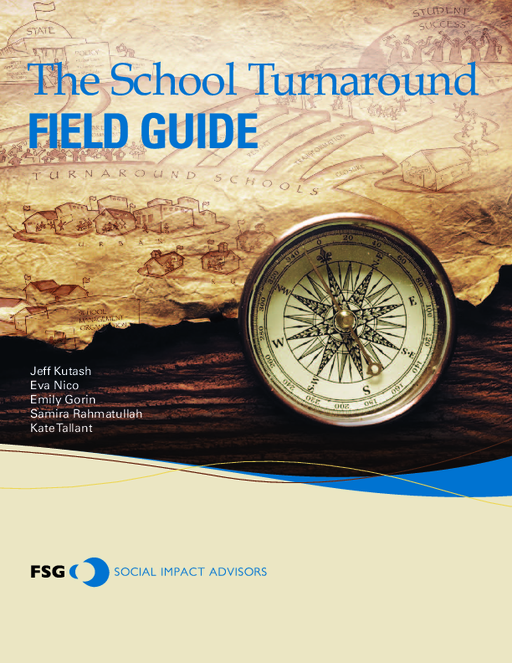Breadcrumb
- Wallace
- Reports
- The School Turnaround Field Guid...
The School Turnaround Field Guide

- Author(s)
- Jeff Kutash, Eva Nico, Emily Gorin, Samira Rahmatullah, and Kate Tallant
- Publisher(s)
- FSG Social Impact Advisors
Summary
How we did this
The researchers drew upon more than 100 interviews with turnaround experts, practitioners, policymakers, researchers, and funders. The research also included an extensive review of secondary reports and articles as well as a synthesis of discussions among 275 turnaround focused actors who attended the “Driving Dramatic School Improvement Conference” on January 11, 2010. Finally, the researchers drew extensively on the guidance and feedback of an advisory group consisting of a broad cross-section of turnaround actors, including state and district leaders, philanthropic funders, human capital providers, school operators, education entrepreneurs, and researchers.
This report compares major approaches to school turnaround, explains how school progress should be measured, and identifies gaps in resources needed to ensure large-scale school turnaround success. "Turnaround" refers to intensive short-term interventions undertaken by a state or district with the goal of dramatically improving the way a school operates.
Measuring Success
The researchers heard broad agreement about the following themes surrounding measures of success:
- At the school level. Measure student outcomes and improvements in the school culture and learning environment; employ absolute and value-added measurements; set the bar for success high; and strive for meaningful improvements within two to three years.
- At the system level. Set turnaround-specific goals for students, schools, and the system; track performance of all schools, not just turnaround schools; evaluate state and district self-performance in supporting turnaround efforts; identify and share best practices.
Four Turnaround Models
The four approaches vary in the cost, human capital, provider capacity, and political will necessary for implementation. They also may differ in efficacy.
- Turnarounds. Replace the principal, rehire no more than 50 percent of the staff, and grant the principal sufficient operational flexibility (including in staffing, calendars, schedules, and budgeting) to implement fully a comprehensive approach that substantially improves student outcomes).
- Restarts. Transfer control of, or close and reopen a school under a school operator that has been selected through a rigorous review process.
- School Closures. Close the school and enroll students in higher-achieving schools.
- Transformations. Replace the principal, take steps to increase teacher and school leader effectiveness, institute comprehensive instructional reforms, increase learning time, create community-oriented schools, and provide operational flexibility and sustained support.
Turnaround Actors
The federal government plays a role as a funder and a catalyst for policy change. In addition to the federal government, there are other key players who help shape the turnaround sector, including states and districts, unions, school operators, and other supporting partners. Some of those may include comprehensive school redesign specialists, human capital and professional development providers, district and school resource management specialists, community-based organizations, and philanthropic funders.
The researchers say their interviews highlight the complexity of the turnaround ecosystem and the need for actors to work together in new ways. For example, states should define relationships with districts that go beyond compliance. For their part, districts should work with unions to establish new conditions at schools.
Lessons Learned
Lessons from the research emerged at the school level and the system level. Some examples of school-level lessons include:
- Identify school leadership early so as to build in planning time to engage the community, establish the vision, and create a new school culture.
- Provide strong classroom and teamwork skills and additional support to teachers.
- Build capacity for long-term sustainable results.
Examples of system-level lessons include:
- Articulate a powerful vision for turnaround and make tough decisions.
- Build accountability and data systems to track progress and inform decisions.
- Build systems and structures that allow for sharing lessons across schools.
Gaps
The research highlights significant gaps that must be addressed to ensure that school turnarounds succeed at scale. There are gaps in capacity, funding, public and political will, research and knowledge sharing, and more.
There are not enough proven turnaround experts or organizations, and there is little capacity to assess the quality of the large number of new entrants to the school turnaround field. There is also a lack of ongoing operational funding to sustain efforts.
Another hurdle is that key actors involved find it challenging to make the difficult decisions required for dramatic school turnaround. And policies and conditions in districts and states are frequently at odds with what is necessary for success in turnaround.

If the U.S. is to transform thousands of its chronically underperforming schools, multiple actors must work together to identify and spread effective practices, create the policies and conditions for success, build capacity, and ensure the sustainability of turnaround work at scale.
Key Takeaways
- Principals who successfully turn around failing schools develop and rely on school leadership teams. They also work in partnership with the district and the community.
- To turn around a failing school, principals need control over staffing, program, budget, and scheduling. The more autonomy principals have, the better schools perform.
- Successful efforts at the school level must be supported by corresponding changes at the system level.

